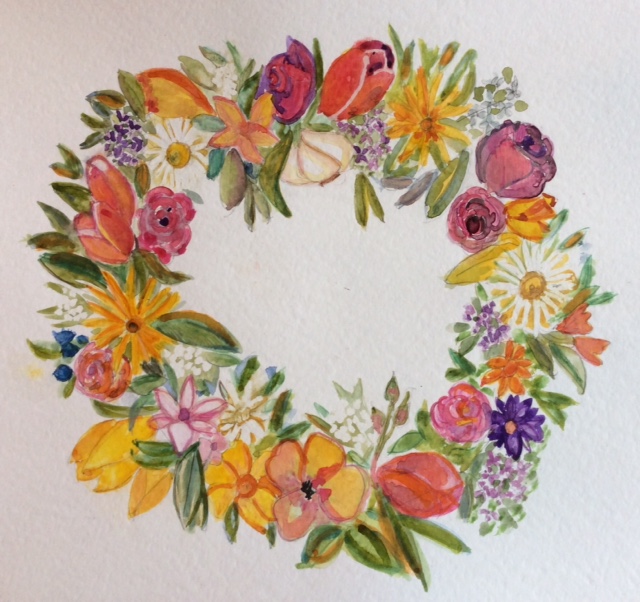
Today, is the first of May, a day that is widely celebrated and that has various traditions attached to it. I am happy to have M. L. Kappa as my special guest for Discovering Traditions. You can find a list of all guest post that have appeared on my blog so far here, and you can find the previous guest post for Discovering Traditions here.
May 1st and the Making of the Wreath by M.L.Kappa

One of the most fun Greek traditions is the making of the May Wreath. We call it Μάης (pronounced Màïs).
May 1st is universally known as Labor Day since 1886, when the Chicago Syndicates rebelled, asking for better working conditions. But celebrating it is not actually a 19th century tradition—it has roots in Antiquity, when festivities were held in honor of Demeter, goddess of the harvest, and Dionysus, god of grapes and wine.
Their purpose was to celebrate the fertility of the fields, the bounty of the land, the flowering of nature and the end of winter.
This tradition in various forms then spread throughout Byzantium and the rest of Europe.
The custom of making a wreath, which is the Greek way of celebrating the day, also started in antiquity when those taking part in the feast of Thargilion (Θαργηλίων), held in honor of the god Sun, would cut a leafy branch, decorate it with ribbons and hang from it bread, figs, and flasks of oil, wine and honey—to symbolize life, health, good luck, happiness and a plentiful harvest.
We call the first of May Πρωτομαγιά (Protomagia). Families vie to make the most beautiful wreath in the neighborhood, wandering around their gardens or the countryside to pick flowers. Of course, some order very chic coordinated wreaths at the florist, but most people think it’s more fun to collect armfuls of blossoms and greenery: daisies and anemones, sprigs of lilac, roses, carnations, tulips, and small branches of olive and laurel leaves. Some like to add a head of garlic, for good luck—garlic wards off disease and the evil eye.
If stuck for quantity—when a family gets together, a wreath has to be made for each house—someone can pop to the nearest road-stand selling flowers stored in an assortment of buckets.
Then a frame is made out of newspaper, folded into strips which are twisted about themselves to form a circle. The flowers are fashioned into little mixed bunches and secured to the frame with string. The wreath should be quite bushy, so each takes up a surprising amount of vegetation.
Nowadays most people buy frames made out of styrofoam; toothpicks are stuck into the base of the flowers and the other end into the frame. Probably easier, but I’m a traditionalist and I prefer the way my mother taught me. I also think it helps the wreath last longer, and dry into a pleasing shape.
When the wreath is ready, it is hung on the front door or on a balcony railing, and there it remains, slowly drying out, until Saint John’s day, on the 23rd of June.
Then family and friends get together again, and build a bonfire; the dried-out wreath is put on top, and when the flames burn down a little, everyone jumps over the fire, in a ritual that is supposed to deflect illness and bring good health. Songs are sometimes sung around the fire and parents wet kids’ hair and clothes before allowing them to jump over the embers.
By sheer coincidence, Greek Easter this year also falls on May 1, so perhaps some eggs or bunnies will be added to the wreath!
Author Bio:
M.L.Kappa writes about life in Greece. Saddened by the mess her country has got itself into, she attempts to describe and comment on what she, and the people around her, are going through – the things she sees, hears and reads about. The good, the bad, and the just plain funny.
Thank you, Solveig, for inviting me. I had fun writing this and doing the drawing. Hugs!
LikeLiked by 2 people
Thank you for accepting my invitation and doing this beautiful post!
LikeLiked by 1 person
Love this. 🌺🌸🌼 Happy May Day!
LikeLiked by 1 person
Reblogged this on beyondtheflow and commented:
Tonight, I have been trying to catch up on my blog reading and found this delightful post about the tradition of Making Wreaths in Greece by ML Kappa. Hope you enjoy it! xx Rowena
LikeLiked by 1 person
An exquisite wreath. Thank you for a breath of spring! ღ
LikeLiked by 1 person
Reblogged this on Letters from Athens and commented:
Solveig Werner very kindly asked me to take part in her ‘Discovering traditions’ series, so I wrote a piece about the first of May, when Greeks make a flower wreath which they hang on their balcony or front door to celebrate the coming of spring.
This year May 1st coincided with Easter, so we had an abundance of celebrations. I took some photos of our wreath-making process, and I encourage everyone to visit Solveig’s blog to read my masterpiece – and, mainly, to discover all the lovely stuff she posts there!
LikeLiked by 1 person
What an interesting tradition!
LikeLiked by 1 person
I enjoyed your post Marina! Thank you for introducing me to Solveig’s blog too.
LikeLiked by 1 person
Nice to meet you Robyn!
LikeLiked by 1 person
What an amazing post! I love this tradition. There’s something joyful and uplifting about it. Thank you for sharing it here. And so lovely to see you on Solveig’s blog as a guest.
LikeLike
What a lovely idea Solveig sharing traditions – nice to read about this particular Greek tradition. 🙂
LikeLike